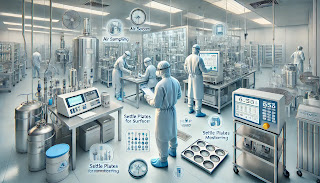1. Virosil 5%
Composition: A stabilized blend of hydrogen peroxide (H₂O₂) and silver ions .
Use: Applied for aerial fumigation, surface disinfection, and cleaning of purified water systems, AHUs, and filling areas.
Mechanism:
*Hydrogen peroxide generates nascent oxygen that oxidizes the cell walls of microorganisms.
*Silver ions disrupt microbial enzyme systems and enhance H₂O₂’s penetration by binding to DNA and membrane proteins .
*This dual action destroys bacteria, fungi, spores, and viruses while leaving no harmful residues (it decomposes into water and oxygen).
Advantages: Non-toxic, chlorine-free, eco-friendly, and replaces carcinogenic formaldehyde fumigation .
2. Bacillocid 2%
Composition: A blend of glutaraldehyde and benzalkonium chloride (a quaternary ammonium compound).
Use: Used for surface disinfection of floors, walls, biosafety cabinets, and cleanroom equipment.
Mechanism:
*Glutaraldehyde cross-links amino groups in microbial proteins and nucleic acids, leading to irreversible cell death.
*QACs disturb cell membranes, causing leakage of cytoplasmic contents.
Spectrum: Effective against bacteria, fungi, and some spores; used widely for decontamination in sterile rooms.
3. IPA 70% (Isopropyl Alcohol)
Composition: 70% isopropyl alcohol in water (the water component facilitates protein denaturation).
Use: A fast-acting disinfectant for wiping stainless steel surfaces, gloves, and equipment in aseptic areas.
Mechanism:
*Alcohol denatures cell wall proteins and dissolves lipid membranes, rapidly killing bacteria and enveloped viruses.
*Ineffective against spores but ideal for daily cleanroom wipe-downs due to quick evaporation and minimal residue.
4. Protozon
Composition: Often a quaternary ammonium compound-based surface disinfectant, occasionally blended with aldehydes or phenolic derivatives (varies by brand).
Use: Routine cleaning of non-critical areas like corridors and gowning zones.
Mechanism: QACs adsorb onto the microbial cell wall, causing structural disorganization and leakage of vital cellular materials.
Note: Acts as a low-level disinfectant, mainly targeting gram-positive bacteria and fungi.
5. Compton
Composition: Typically a hydrogen peroxide and silver nitrate compound (similar profile to Virosil), used for high-level disinfection.
Use: Deployed for periodic fumigation or surface cleaning of critical zones, AHUs, and water pipelines.
Mechanism:
*Releases nascent oxygen that oxidizes microbial components.
*Silver stabilizes the formulation and prolongs the residual antimicrobial effect.
6. Hydrogen Peroxide (H₂O₂)
Concentration Used: Generally 3–6% for surface disinfection; 30–35% in vapor form for decontamination (VHP).
Use: Used for sterilization of isolators, pass boxes, and clean room environments.
Mechanism:
*Produces reactive oxygen species (ROS) that oxidize lipids, proteins, and DNA.
*Completely decomposes into water and oxygen, leaving no residue.
Advantages: Broad-spectrum sporicidal activity and environmentally safe.
These disinfectants are selected in rotation cycles under GMP guidelines to prevent microbial adaptation and to maintain effective contamination control across grades (A–D) in cleanrooms.











